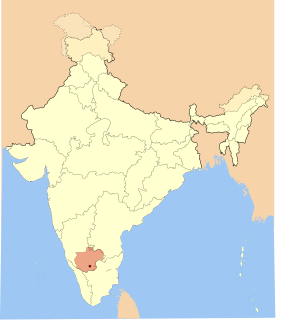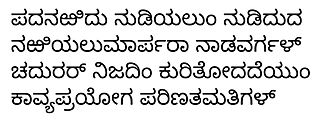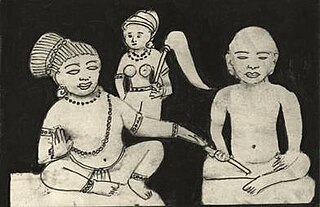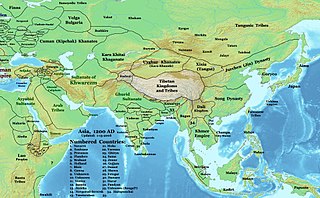
Kannada literature is the corpus of written forms of the Kannada language, a member of the Dravidian family spoken mainly in the Indian state of Karnataka and written in the Kannada script.

Amoghavarsha I was a Rashtrakuta emperor, the greatest ruler of the Rashtrakuta dynasty, and one of the great emperors of India. His reign of 64 years is one of the longest precisely dated monarchical reigns on record. Many Kannada and Sanskrit scholars prospered during his rule, including the great Indian mathematician Mahaviracharya who wrote Ganita-sara-samgraha, Jinasena, Virasena, Shakatayan and Sri Vijaya. Amoghavarsha I was an accomplished poet and scholar. He wrote the Kavirajamarga, the earliest extant literary work in Kannada, and Prashnottara Ratnamalika, a religious work in Sanskrit. During his rule he held titles such as Nrupathunga, Atishadhavala, Veeranarayana, Rattamarthanda and Srivallabha. He moved the Rashtrakuta regal capital from Mayurkhandi in the Bidar district to Manyakheta in the Gulbarga district in the modern Karnataka state. He is said to have built the regal city to "match that of Lord Indra". The capital city was planned to include elaborately designed buildings for the royalty using the finest of workmanship. The Arab traveler Sulaiman described Amoghavarsha as one of the four great kings of the world. Sulaiman also wrote that Amoghavarsha respected Muslims and that he allowed the construction of mosques in his cities. For his religious temperament, his interest in the fine arts and literature and his peace-loving nature, historian Panchamukhi has compared him to the emperor Ashoka and given him the honorific "Ashoka of the South". Amoghavarsha seems to have entertained the highest admiration for the language, literature and culture of the Kannada people as testified to in the text Kavirajamarga.

Rashtrakuta was a royal Indian dynasty ruling large parts of the Indian subcontinent between the sixth and 10th centuries. The earliest known Rashtrakuta inscription is a 7th-century copper plate grant detailing their rule from Manapura, a city in Central or West India. Other ruling Rashtrakuta clans from the same period mentioned in inscriptions were the kings of Achalapur and the rulers of Kannauj. Several controversies exist regarding the origin of these early Rashtrakutas, their native homeland and their language.

Western Ganga was an important ruling dynasty of ancient Karnataka in India which lasted from about 350 to 1000 CE. They are known as "Western Gangas" to distinguish them from the Eastern Gangas who in later centuries ruled over Kalinga. The general belief is that the Western Gangas began their rule during a time when multiple native clans asserted their freedom due to the weakening of the Pallava empire in South India, a geo-political event sometimes attributed to the southern conquests of Samudra Gupta. The Western Ganga sovereignty lasted from about 350 to 550 CE, initially ruling from Kolar and later, moving their capital to Talakadu on the banks of the Kaveri River in modern Mysore district.

Kavirajamarga is the earliest available work on rhetoric, poetics and grammar in the Kannada language. It was inspired by or written in part by the famous Rashtrakuta King Amoghavarsha I, and some historians claim it is based partly on the Sanskrit text Kavyadarsha. Some historians believe Kavirajamarga may have been co-authored by a poet in the king's court, the Kannada language theorist Sri Vijaya.
Pampa, called by the honorific Ādikavi was a Kannada-language Jain poet whose works reflected his philosophical beliefs. A court poet of Chalukya king Arikesari II, who was a feudatory of the Rashtrakuta dynasty king Krishna III, Pampa is best known for his epics Vikramārjuna Vijaya or Pampa Bharata, and the Ādi purāṇa, both written in the champu style around c.939. These works served as the model for all future champu works in Kannada.

Chavundraya or Chamundaraya was an Indian military commander, architect, poet and minister. He served in the court of the Western Ganga dynasty of Talakad. A person of many talents, in 982 he commissioned the construction of the monolithic statue of Bahubali, the Gomateshwara, at Shravanabelagola, an important place of pilgrimage for Jainism. He was a devotee of the Jain Acharya Nemichandra and Ajitasena Bhattaraka and was an influential person during the reigns of Marasimha II Satyavakya, (963–975). Rachamalla IV Satyavakya, (975–986) and Rachamalla V (Rakkasaganga), (986–999).
Ponna (c. 945) was a noted Kannada poet in the court of Rashtrakuta Dynasty king Krishna III (r.939–968 CE). The emperor honoured Ponna with the title "emperor among poets" (Kavichakravarthi) for his domination of the Kannada literary circles of the time, and the title "imperial poet of two languages" for his command over Sanskrit as well. Ponna is often considered one among the "three gems of Kannada literature" for ushering it in full panoply. According to the scholar R. Narasimhacharya, Ponna is known to have claimed superiority over all the poets of the time. According to scholars Nilakanta Shastri and E.P. Rice, Ponna belonged to Vengibisaya in Kammanadu,Andhra Pradesh, but later migrated to Manyakheta, the Rashtrakuta capital, after his conversion to the Jainism.

Hoysala literature is the large body of literature in the Kannada and Sanskrit languages produced by the Hoysala Empire (1025–1343) in what is now southern India. The empire was established by Nripa Kama II, came into political prominence during the rule of King Vishnuvardhana (1108–1152), and declined gradually after its defeat by the Khalji dynasty invaders in 1311.

A large body of Western Chalukya literature in the Kannada language was produced during the reign of the Western Chalukya Empire in what is now southern India. This dynasty, which ruled most of the western Deccan in South India, is sometimes called the Kalyani Chalukya Dynasty after its royal capital at Kalyani, and sometimes called the Later Chalukya Dynasty for its theoretical relationship to the 6th-century Chalukya dynasty of Badami. For a brief period (1162–1183), the Kalachuris of Kalyani, a dynasty of kings who had earlier migrated to the Karnataka region from central India and served as vassals for several generations, exploited the growing weakness of their overlords and annexed the Kalyani. Around 1183, the last Chalukya scion, Someshvara IV, overthrew the Kalachuris to regain control of the royal city. But his efforts were in vain, as other prominent Chalukya vassals in the Deccan, the Hoysalas, the Kakatiyas and the Seunas destroyed the remnants of the Chalukya power.
Nāgavarma I (c. 990) was a noted Jain writer and poet in the Kannada language in the late 10th century. His two important works, both of which are extant, are Karnātaka Kādambari, a champu based romance novel and an adaptation of Bana's Sanskrit Kādambari, and Chandōmbudhi, the earliest available work on Kannada prosody which Nāgavarma I claims would command the respect even of poet Kalidasa. According to the scholars K.A. Nilakanta Shastri and R. Narasimhacharya, Nāgavarma I belonged to a migrant Brahmin family originally from Vengi. According to the modern Kannada poet and scholar Govinda Pai, Nāgavarma I lived from 950 CE to 1015 CE. So popular was Nāgavarma I's poetic skills that King Bhoja of Malwa presented him with horses, in appreciation of his poetic skills.

Western Ganga literature refers to a body of writings created during the rule of the Western Ganga Dynasty, a dynasty that ruled the region historically known as Gangavadi between the 4th and 11th centuries. The period of their rule was an important time in the history of South Indian literature in general and Kannada literature in particular, though many of the writings are deemed extinct. Some of the most famous poets of Kannada language graced the courts of the Ganga kings. Court poets and royalty created eminent works in Kannada language and Sanskrit language that spanned such literary forms as prose, poetry, Hindu epics, Jain Tirthankaras (saints) and elephant management.
Medieval Kannada literature covered a wide range of subjects and genres which can broadly be classified under the Jain, Virashaiva, Vaishnava and secular traditions. These include writings from the 7th century rise of the Badami Chalukya empire to the 16th century, coinciding with the decline of Vijayanagara Empire. The earliest known literary works until about the 12th century CE were mostly authored by the Jainas along with a few works by Virashaivas and Brahmins and hence this period is called the age of Jain literature,. The 13th century CE, to the 15th century CE, saw the emergence of numerous Virashaiva and Brahminical writers with a proportional decline in Jain literary works. Thereafter, Virashaiva and Brahmin writers have dominated the Kannada literary tradition. Some of the earliest metres used by Jain writers prior to 9th century include the chattana, bedande and the melvadu metres, writings in which have not been discovered but are known from references made to them in later centuries. Popular metres from the 9th century onwards when Kannada literature is available are the champu-kavyas or just champu, vachanasangatya, shatpadi, ragale, tripadi, and kavya.

Mysore literature in Kannada is a body of literature composed in the Kannada language in the historical Kingdom of Mysore in Southern India and written in the Kannada script. The writings date from the Kingdom of Mysore, which existed from around 1600 CE until the establishment of modern India in 1947. Many of the works of this literature written on religious themes are labeled Veerashaiva or Vaishnava in acknowledgment of the two faiths that gave form to the literature and fostered it until the advent of the modern era. Despite a gradual decline in the popularity of Jainism, authors devoted to the faith produced some works of merit. Secular themes dealing with a wide range of subjects were also written on. Kannada literature flourished for a short while in the court of the neighbouring kingdom of the Nayakas of Keladi whose territory was annexed by Mysore in 1763.

Vijayanagara literature in Kannada is the body of literature composed in the Kannada language of South India during the ascendancy of the Vijayanagara Empire which lasted from the 14th through the 16th century. The Vijayanagara empire was established in 1336 by Harihara I and his brother Bukka Raya I. Although it lasted until 1664, its power declined after a major military defeat by the Shahi Sultanates in the battle of Talikota in 1565. The empire is named after its capital city Vijayanagara, whose ruins surround modern Hampi, now a World Heritage Site in Karnataka.
Extinct Kannada literature is a body of literature of the Kannada language dating from the period preceding the first extant work, Kavirajamarga.
Andayya was a notable 13th-century Kannada writer during the rule of the Hoysala empire. Andayya was a Jain by faith and came from a family of accountants. His most important extant work is the Kabbigara Kava which also goes by the names Sobagina Suggi, Madana Vijaya or Kavana Gella and was written in the 1217–1235 CE period.
Asaga was a 9th-century Digambara Jain poet who wrote in Sanskrit and Kannada language. He is most known for his extant work in Sanskrit, the Vardhaman Charitra. This epic poem which runs into eighteen cantos was written in 853 CE. It is the earliest available Sanskrit biography of the last tirthankara of Jainism, Mahavira. In all, he authored at least eight works in Sanskrit. In Kannada, none of his writings, including the Karnataka Kumarasambhava Kavya that have been referenced by latter day poets have survived.
Nagachandra or Abhinava Pampa was a 12th-century poet in the Kannada language.












